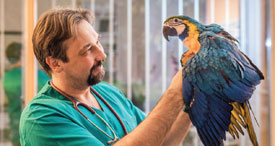Pet ownership, spending going strong
The American Pet Products Association reports that about two-thirds of U.S. households own pets, and spending on pets is increasing—including spending on veterinary care.
The APPA biennial survey of pet owners found that 67% of U.S. households owned at least one pet in 2018, an estimated 84.9 million homes. The AVMA, using a different methodology, found that 56.8% of U.S. households owned pets as of year-end 2016.
According to the APPA, millennials represent the largest segment of pet owners for all pet types, especially birds, small exotic companion mammals, and saltwater fish. More than 80% of pet owners among millennials and Generation Z own dogs, while 50% or less own cats. The APPA defines millennials as being born from 1980-94 and surveyed members of Generation Z, the following generation, aged at least 18.
 The annual APPA report on pet spending found that overall spending in the U.S. pet industry increased 4.4% from 2017-18 to $72.56 billion.
The annual APPA report on pet spending found that overall spending in the U.S. pet industry increased 4.4% from 2017-18 to $72.56 billion.
"Millennials continue to be the largest pet-owning demographic and this shows in the data," said Bob Vetere, APPA president and CEO, in an announcement about the report. "We know this generation is willing to pay more for quality products and services to improve the health and well-being of their pets. Today more than ever, pet owners view their pets as irreplaceable members of their families and lives, and it's thanks to this that we continue to see such incredible growth within the pet care community."
According to the APPA, spending on veterinary care increased 6.1% to $18.11 billion in 2018. The AVMA found that total annual spending on veterinary care for all types of pets was $27.8 billion as of 2016. The APPA predicts a 4.8% increase in spending on veterinary care for 2019.
Spending on pet food increased 4.3% between 2017 and 2018 to $30.32 billion, according to the APPA. In the category of pet supplies and over-the-counter medications, spending increased 6.0% to $16.01 billion. Spending on pet services such as grooming, boarding, walking, training, pet sitting, and yard services decreased 0.8% to $6.11 billion. Spending on purchases of pets decreased 4.3% to $2.01 billion.
Related JAVMA content:
Pet ownership stable, veterinary care variable (Jan. 15, 2019)
Spending on pets approaches $70 billion (May 1, 2018)
Millennials now primary pet-owning demographic (May 15, 2017)